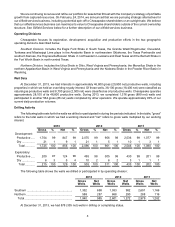Chesapeake Energy 2013 Annual Report Download - page 21
Download and view the complete annual report
Please find page 21 of the 2013 Chesapeake Energy annual report below. You can navigate through the pages in the report by either clicking on the pages listed below, or by using the keyword search tool below to find specific information within the annual report.13
production. The effect of these regulations is to limit the amount of natural gas and oil we can produce and to limit the
number of wells and the locations at which we can drill.
Oilfield Services Operations
Our oilfield services business operates under the jurisdiction of a number of regulatory bodies that regulate worker
safety standards, the handling of hazardous materials, the transportation of explosives and other hazardous materials,
the protection of the environment and standards of operation for driving. Regulations concerning equipment certification
create an ongoing need for regular maintenance that is incorporated into our operating procedures.
In providing trucking services, we operate as a motor carrier and therefore are subject to regulation by the DOT
and various state agencies. These regulatory authorities exercise broad powers governing activities such as the
authorization to engage in motor carrier operations and regulatory safety, financial reporting and certain mergers,
consolidations and acquisitions. Interstate motor carrier operations are subject to safety requirements prescribed by
the DOT and, to a large degree, intrastate motor carrier operations are subject to safety regulations that mirror federal
regulations. Such matters as weight and dimension of equipment are also subject to federal and state regulations, and
DOT regulations mandate drug testing of drivers. Additional regulations specifically relate to the trucking industry,
including testing and specification of equipment and product handling requirements. Our compliance with certain DOT
regulations is tracked by DOT’s Federal Motor Carrier Safety Administration, which develops a company-specific safety
rating based on inspections of our motor carrier operations. Our safety rating can directly affect the Company’s ability
to obtain and renew permits and authorizations.
The trucking industry is subject to possible regulatory and legislative changes that may affect the economics of
the industry by requiring changes in operating practices or by changing the demand for common or contract carrier
services or the cost of providing truckload services. Some of these possible changes include increasingly stringent
environmental regulations, changes in the hours of service regulations that govern the amount of time a driver may
drive in any specific period, onboard black box recorder devices or limits on vehicle weight and size. From time to time,
various legislative proposals are introduced, such as proposals to increase federal, state, or local taxes, including taxes
on motor fuels, which may increase our costs or adversely impact the recruitment of drivers. We cannot predict whether,
or in what form, any increase in such taxes applicable to us will be enacted.
Midstream Operations
Historically, Chesapeake invested, directly and through an affiliate, in gathering systems and processing facilities
to complement our natural gas operations in regions where we had significant production and additional infrastructure
was required. In 2013 and 2012, we sold substantially all of our midstream business and most of our gathering assets.
As a result, the impact on our business of compliance with the laws and regulations described below has decreased
significantly beginning in late 2012.
In addition to the environmental, health and safety laws and regulations discussed below under Environmental,
Health and Safety Matters, a small amount of our midstream facilities is subject to federal regulation by the Pipeline
and Hazardous Materials Safety Administration (PHMSA) of the DOT pursuant to the Natural Gas Pipeline Safety Act
of 1968 (NGPSA) and the Pipeline Safety Improvement Act of 2002 which was reauthorized and amended by the
Pipeline Inspection, Protection, Enforcement and Safety Act of 2006. The NGPSA regulates safety requirements in
the design, construction, operation and maintenance of gas pipeline facilities.
States are largely preempted by federal law from regulating pipeline safety for interstate lines but most are certified
by the DOT to assume responsibility for enforcing federal intrastate pipeline regulations and inspection of intrastate
pipelines. In practice, because states can adopt stricter standards for intrastate pipelines than those imposed by the
federal government for interstate lines, states vary considerably in their assertion of authority and capacity to address
pipeline safety. Our natural gas pipelines have inspection and compliance programs designed to keep the facilities in
compliance with applicable pipeline safety and pollution control laws and regulations.
Natural gas gathering and intrastate transportation facilities are exempt from the jurisdiction of the FERC under
the Natural Gas Act. Although the FERC has made no formal determinations with regard to any of our facilities, we
believe that our natural gas pipelines and related facilities are engaged in exempt gathering and intrastate transportation
and, therefore, are not subject to the FERC's jurisdiction.
FERC regulation affects our gathering and compression business generally. The FERC provides policies and
practices across a range of natural gas regulatory activities, including, for example, its policies on open access
transportation, market manipulation, ratemaking, capacity release and market transparency, and market center
























